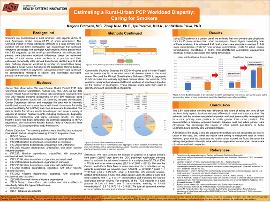| dc.contributor.author | Erdmann, Marjorie | |
| dc.contributor.author | Miao, Zhuqi | |
| dc.contributor.author | Paramel, Ipe | |
| dc.contributor.author | Paiva, William | |
| dc.date.accessioned | 2023-09-12T16:44:52Z | |
| dc.date.available | 2023-09-12T16:44:52Z | |
| dc.date.issued | 2022-02-18 | |
| dc.identifier | ouhd_Erdmann_estimatingaruralurban_2022 | |
| dc.identifier.citation | Erdmann, M., Miao, Z., Paramel, I., & Paiva, W. (2022, February 18). Estimating a rural-urban PCP workload disparity: Caring for smokers. Poster presented at Research Days at Oklahoma State University Center for Health Sciences, Tulsa, Ok. | |
| dc.identifier.uri | https://hdl.handle.net/11244/339517 | |
| dc.description.abstract | Background: Smokers are concentrated in rural America. CDC reports 28.5% of rural Americans smoke versus 25.1% of urban Americans. The workload impact of those additional smokers in a rural primary care practice has not been investigated. We hypothesize that workload difference associated with caring for rural smokers will be greater than the 3.4% suggested by the smoking rate difference. We will calculate primary care physician workload differences based on number of rural versus urban smoker comorbidities. Defining physician workload by number of comorbidities being managed is novel. Given that payers are associating disease management metrics to payment, calculating primary care workload by comorbidities managed is salient and illuminates real-world primary care workload differences. | |
| dc.description.abstract | Methods: We hold constant the number of patients in a typical primary care panel (2500) to estimate the volume of smokers in a rural practice (28.5% of 2500 = 712.5) and in an urban practice (25.1% of 2500 = 627.5). We use the Cerner Health Facts Data Base to determine rates of comorbidities among patients designated as smokers from 1/1/2010 to 9/18/2017 (n = 7,757,949; rural = 1,337,423, urban = 6,420,526). We estimate smoker-related comorbidities using the rates of rural and urban patients with 1, 2, 3 or 4+* comorbidities and multiply the rate by rural/urban smoker volume. For example, of the 712.5 patients in a rural practice, 14.73% of them have 3 comorbidities, resulting in 314.85 comorbidities (712.5 * .1473 * 3 = 314.85). We total all estimated number of comorbidities and compare rural and urban. | |
| dc.description.abstract | Results: Using 2500 patients in a patient panel, we estimate that rural primary care physicians care for 85 more smokers than urban counterparts. Due to higher comorbidity rates of those smokers, it is estimated that rural primary care physicians manage 319.54 more comorbidities (2,367.07 rural smoker comorbidities, 2,047.53 urban smoker comorbidities), constituting a 15.6% comorbidity management workload increase associated with caring for smokers. | |
| dc.description.abstract | Conclusions: The 3.5% rural-urban smoking rate difference falls short of telling the story of how smokers impact physician workload differently in rural and urban practices. We estimate that the smoker associated physician workload (comorbidity management) in a rural primary care practice is 16% greater than urban practice. This demonstrates a sizeable workload disparity between rural and urban primary care physicians. We encourage the review of other patient populations to better understand rural primary care workload inflation. | |
| dc.description.abstract | *Patients with more than 4 comorbidities were aggregated to the 4 conditions. Even if they had more comorbidities only 4 were calculated per patient. Therefore, comorbidity rate differences may be greater or less than reported. Since rural patients are sicker, the assumption is that comorbidity management differences are likely underreported in this study. | |
| dc.format | application/pdf | |
| dc.language | en_US | |
| dc.publisher | Oklahoma State University Center for Health Sciences | |
| dc.rights | The author(s) retain the copyright or have the right to deposit the item giving the Oklahoma State University Library a limited, non-exclusive right to share this material in its institutional repository. Contact Digital Resources and Discovery Services at lib-dls@okstate.edu or 405-744-9161 for the permission policy on the use, reproduction or distribution of this material. | |
| dc.title | Estimating a rural-urban PCP workload disparity: caring for smokers | |
| osu.filename | ouhd_Erdmann_estimatingaruralurban_2022.pdf | |
| dc.type.genre | Presentation | |
| dc.type.material | Text | |
| dc.subject.keywords | smokers | |
| dc.subject.keywords | rural primary care | |
| dc.subject.keywords | workload | |
